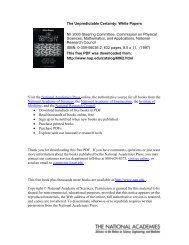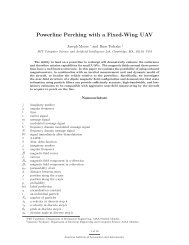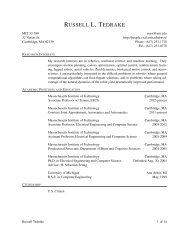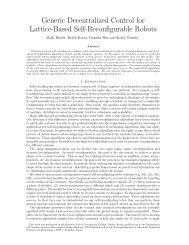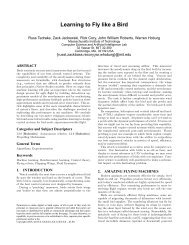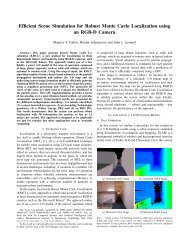Online Social Networks and E-Commerce - MIT Computer Science ...
Online Social Networks and E-Commerce - MIT Computer Science ...
Online Social Networks and E-Commerce - MIT Computer Science ...
Create successful ePaper yourself
Turn your PDF publications into a flip-book with our unique Google optimized e-Paper software.
Clarence Lee <strong>and</strong> Shirley Fung<br />
Similar to Title V of GLBA, our proposed accountability structure should serves four purposes: 1) inform<br />
consumer about the types of information stored, 2) allow user to have control over what data to be<br />
released, 3) st<strong>and</strong>ardize <strong>and</strong> require all businesses to draft protection plan, <strong>and</strong> 4) establish enforcement<br />
authority.<br />
Inform Consumers About Information Stored<br />
While the Financial Privacy Rule holds business accountable to educate the user about privacy protection,<br />
one of the biggest complaints is that there is no st<strong>and</strong>ardized way of displaying that information to the<br />
user. GLBA leaves the burden of deciding the format in which the privacy policy is present on the<br />
business, <strong>and</strong> hence many businesses would often present the privacy policy in a long <strong>and</strong> convoluted<br />
manner in order to discourage the consumers from reading it. This defeats the purpose <strong>and</strong> we propose<br />
that an easy to underst<strong>and</strong> structure to be established to educate the user.<br />
One possibility would be to leverage the Platform for Privacy Preferences (P3P) Project. Developed by the<br />
World Wide Web Consortium, the P3P Project “enables Websites to express their privacy practices in a<br />
st<strong>and</strong>ard format that can be retrieved automatically <strong>and</strong> interpreted easily by user agents (Platform for<br />
Privacy Preferences (P3P) Project).”<br />
Another possibility would be to use a simple visual chart to display the kinds of information stored on<br />
third party Web sites. Similar to the Nutritional Facts chat found on all packaged foods in the United<br />
States, a simple, st<strong>and</strong>ardized chart like that can effectively educate the user about information stored.<br />
Allow User to Control Data Released<br />
Another improvement upon the GLBA system would be to provide a simple way for users to opt-out.<br />
While the current GLBA system allow users to opt-out from having their Financial information shared<br />
with non-affiliated companies, the opt-out description is often confusing to read <strong>and</strong> hard to underst<strong>and</strong>.<br />
This places the burden of decision on the consumer to learn about the possible opt-out options <strong>and</strong><br />
actually going through the complicated procedures of opting-out. While this sounds like it is trying to<br />
protect the consumer on paper, in reality the rule is not very effective. Companies can do whatever they<br />
want with the consumer data as long as the user does not opt-out, hence this creates an incentive for<br />
businesses to make the opt-out procedure to be as complicated as it can be.<br />
Having an easy-to-underst<strong>and</strong> opt-out description would actually give consumers the power of decision.<br />
While we could have proposed an opt-in system where users have to opt-in to allow companies to share<br />
any consumer information at all, we feel that this would be too restricting on businesses in that almost no<br />
consumer would actually volunteer to have their information be shared. Since we believe that this option<br />
will garner much resistance from businesses, we feel that the clear opt-out approach would be a better<br />
compromise.<br />
Page 34



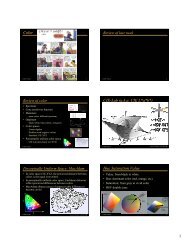
![[ti]The “Vulgar Spirit of Blogging”: On Language, Culture ... - CSAIL](https://img.yumpu.com/18604217/1/190x245/tithe-vulgar-spirit-of-blogging-on-language-culture-csail.jpg?quality=85)




